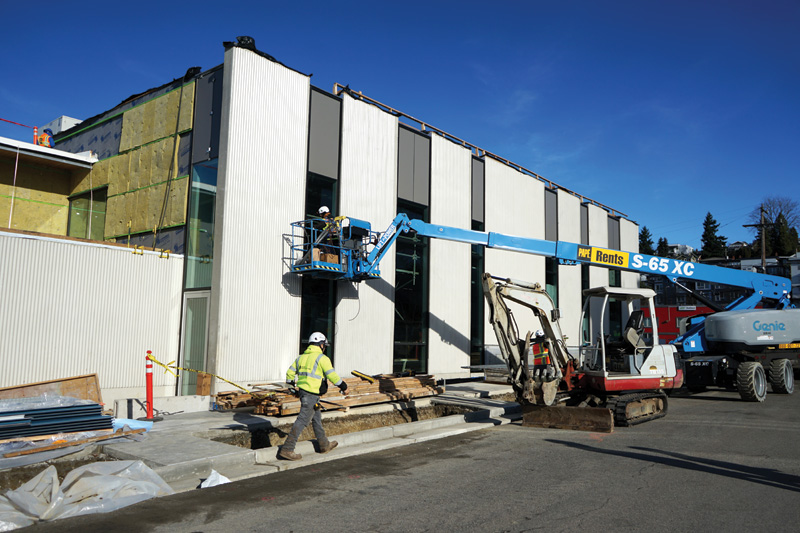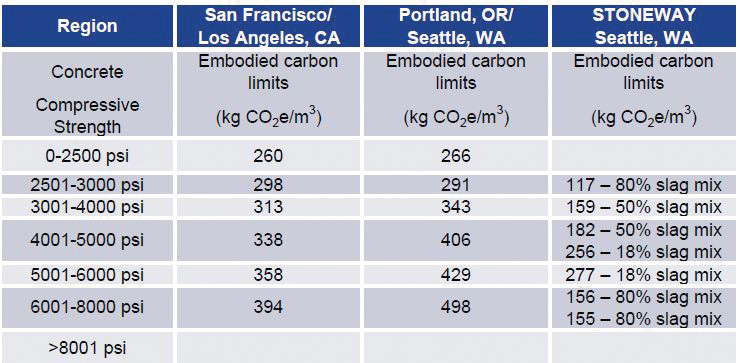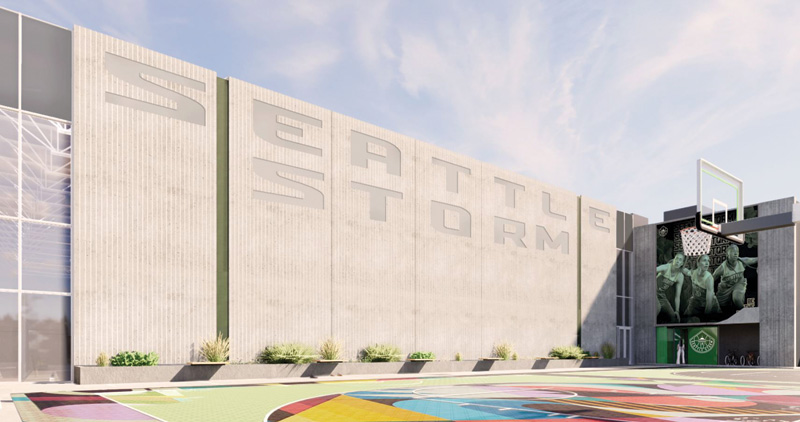A winning foundation: Solid defense with low carbon concrete
by tanya_martins | April 9, 2025 3:43 pm
By Aubrey Smading and Lionel Lemay
 [1]
[1]With four WNBA titles, the Seattle Storm are used to excellence on the court. These winning ways have now extended beyond the court as the team’s new $64-million training facility—the Seattle Storm Center for Basketball Performance—was named a winner in the National Ready Mixed Concrete Association’s (NRMCA) 2024 Concrete Innovation Awards.
The award, announced in March, was given in recognition of the 4,645-m2 (50,000-sf) project, achieving a significant reduction in greenhouse gas (GHG) emissions from the concrete. It achieved 52.4 percent embodied carbon savings compared to the regional industry average 28-day standard-cured compressive strength, rising to as much as 68 percent with specific applications in the building. The facility was designed by architects Shive-Hattery and ZGF Architects and built by Sellen Construction. An NRMCA member supplied the low-carbon concrete required to meet the project’s sustainability goals.
For a team that plays in the Climate Pledge Arena (the first net-zero carbon-certified arena in the world) in a city that passed new building performance standards to reach net-zero by 2050, reducing the carbon footprint of the Storm’s training facility was a key consideration from the earliest stages of the project’s conception. In addition, the project targeted LEED Gold certification to qualify for the city of Seattle’s Priority Green expedited program. These stipulations meant emissions reduction was a key driver of decisions throughout the design and construction processes.
 [2]
[2]A three-pronged approach
To meet this low-carbon need, the architects and concrete supplier adopted three key strategies: deploying strength requirements based on concrete compressive strength tests at 56 days instead of a typical 28-day test age for specific applications, using higher slag cement replacement of between 50 and 80 percent, and implementing Type IL portland-limestone cement (PLC).
The design and construction teams worked closely to identify parts of the project that could be specified with a design strength of 56 days rather than the typical 28 days. The longer curing schedule allows for reduced embodied carbon and a lower global warming potential (GWP) of the completed building by reducing the need for high amounts of cementitious materials to achieve the required strength. In appropriate locations, specifying strength requirements at 56 days rather than 28 days should have little or no effect on the final strength and performance. With the strategic selection of project areas for a 56-day curing schedule, the team was able to minimize impacts on the construction time and cost.
Sections of the project, such as the foundations and the tilt-up walls, were identified as appropriate for specifying the design strength at 56 days. The project was fortunate that the Seattle area has extensive experience working with 56-day design strength, as it has been common in the city since the 1980s. To allow crews to get on the slab quickly, the concrete supplier adjusted the admixture by minimizing the amount of water reducer and using a superplasticizer and a viscosity modifier—producing an admixture that met the approval of the project’s finishers.
The design called for lighter, whiter concrete for the structure. Two initial options were considered, but they were either too expensive or had a high carbon footprint. Adding titanium dioxide as a color additive was cost-prohibitive, and getting white cement meant transporting a specific cement across the country.
The solution was using high slag cement content in the concrete. Mix designs that use 50 percent slag have been developed regularly for other construction projects, such as the Microsoft Campus refresh currently underway in Redmond, WA. Mix designs of up to 80 percent were used on The Spheres at Amazon’s corporate office in downtown Seattle, producing a very light color after drying.
In total, 27 percent of the Storm Center’s concrete used 80 percent slag cement; 64 percent used 50 percent slag cement. Initial issues with cracking due to set times were resolved quickly, so the admixture combinations were adjusted to reduce set time. Tilt walls were designed for 41,368 kPa (6,000 psi) at 56 days and used 80 percent slag replacement, but they were still able to achieve 27,579 kPa (4,000 psi) within three days to comply with the placement schedule. To achieve this, wireless maturity sensors were used to confirm the strength requirements were met within three days.
 [3]
[3]Slag cement also brought environmental and sustainability benefits that contributed to the overall GWP and embodied carbon reductions of the project. Not only does replacing a portion of portland cement with slag cement hold the potential to reduce the environmental impact of the concrete significantly, but it also requires nearly 90 percent less energy to produce than portland cement. According to the Slag Cement Association, using 50 percent of slag in the cementitious content can reduce GHGs by more than 40 percent and lower the embodied energy of concrete by more than 30 percent.
The Storm Center’s GWP requirements were met, along with maximum cement content. In addition, all the cement used was Type IL: the project used ASTM C595 Type IL portland-limestone cement (PLC). As PLC uses a higher blend of limestone, it can result in carbon savings of up to 10 percent across the lifecycle of a project. As the concrete supplier successfully used this mix design on a previous project, the team was confident that performance requirements would be met. In general, the company has found success with the use of Type IL through testing, mockups, and appropriate mixture adjustments.
In addition, the project used ready-mix admixture and fiber technologies to help exceed the specified embodied carbon limits and overall performance. The teams collaborated to identify the best low-carbon mixes for each intended application throughout the design and construction process.
 [4]
[4]Creating a healthy and productive building
As a sports training facility for elite athletes, there was a strong desire to prioritize health and wellness in design, construction, and operation. As a result, rather than just resting at LEED Gold, the client, contractors, and architects were keen to push further and reduce operational carbon emissions resulting from the energy used to operate the facility. The commitments made by the City of Seattle and Washington State to transition to all-electric systems for decarbonizing the building stock created a smoother path for the project team to achieve these goals than other regions might face.
Moreover, the local utility the project is connected to already sources most of its power from renewables. More than 80 percent of Seattle City Light’s power comes from hydroelectric projects on the Skagit and Pend Oreille Rivers. In addition, the city required the project to install photovoltaics (PV) on the building’s roof. Low-volatile organic compound (VOC) materials were used inside the building to reduce the carbon and wider GHG impacts on the interiors and the players themselves.
Meeting the tight timeline
Speed was also of the essence for this project. Construction of the facility began in spring 2023, and the team wanted to be in the building by the start of the 2024 season in late April. The project’s sustainability commitments helped them in this regard: The City of Seattle’s Department of Construction and Inspections runs a program called Priority Green Expedited, which reduces permitting wait times in exchange for meeting a green building certification and other criteria.
As the building was chasing LEED Gold and similar sustainability goals, the project qualified for Priority Green Expedited, which aims to shorten initial plan review times by at least 50 percent. As a result, the project was given crucial extra time back to focus on construction.
 [5]
[5]A collective commitment to low-carbon
The combination of approaches resulted in a project that met and exceeded its GWP and embodied carbon goals. Overall, the project exceeded a 50 percent reduction compared to typical average mixes in the region and achieved 80 percent of the 2030 targeted reductions of the World Economic Forum’s First Movers Coalition for “near zero carbon: concrete.”
The achievement was a team effort and the result of implementing an early collaborative process with the contractor, architect, and design and project teams that identified what objectives were required to meet or exceed the client’s sustainability goals. Architects ZGF noted these carbon reductions are the highest they had seen on a project.
The thermal buffering provided by the exposed concrete has a particularly pronounced effect on the building’s energy efficiency and GWP over its lifetime. The concrete absorbs heat in warmer weather to minimize its impact on indoor temperatures and releases that heat when temperatures cool down. Strategic placement of this thermal buffering—such as in the walls, as is the case with the Storm Center—is a strong, long-term step toward reducing the building’s operation carbon and GWP.
Other design decisions specific to buildings of this type further helped the project meet its energy efficiency and GWP goals. Since the practice courts require consistent lighting, large parts of the building’s exterior have a very low window-to-wall ratio. In this case, it was approximately 6 percent compared to a more typical 30 or 40 percent. As windows are traditionally the weak link in a thermal envelope, this design consideration specific to a basketball practice facility will help the Storm Center reduce energy consumption and costs. When taken
into consideration alongside the PV solar array installed on
the roof of the building, the full suite of operational efficiencies has enabled the Storm Center to reduce its energy costs by 46 percent compared to the LEED energy baseline.
Keeping carbon reduction at the core
Ultimately, ensuring a project stays true to the principles of carbon neutrality rests on the client’s motivations. It is common for professionals in the industry to rely on tried, tested, and trusted techniques and mixtures that have proven effective for specific buildings and other infrastructure. While the project’s low-carbon concrete mixtures were not experimental as they had been previously deployed on other projects, they remained largely outside the industry norms. A client that is invested in keeping the project tied to its low-carbon goals and partners across the project that are experienced and committed to doing the same will make sure that design and construction decisions have sustainability as a key metric in addition to the usual pillars of safety, reliability, durability, and cost.
From training in a university sports hall that was only available from 10 a.m. to 2 p.m. to have its own state-of-the-art facility that exceeds LEED Gold, the Seattle Storm are setting new standards on and off the court. Much of this is due to the commitment of professionals to devise solutions to meet their long-term, low-carbon needs.
Authors
 [6]
[6]
Aubrey Smading, P.E., is the director of concrete design and technology at the
Portland Cement Association (PCA) and works to advance the PCA Roadmap to Carbon Neutrality.
 [7]
[7]
Lionel Lemay, P.E., SE, LEED AP, is the executive vice president of structures
and sustainability for the National Ready Mixed Concrete Association (NRMCA).
Key Takeaways
The Seattle Storm Center for Basketball Performance, a $64-million, 4,645-m2 (50,000-sf) facility, won the 2024 Concrete Innovation Award for its low-carbon design. It achieved 52.4 percent embodied carbon savings using 56-day strength testing, up to 80 percent slag cement replacement, and Type IL portland-limestone cement. The project also integrated solar panels, low volatile organic compound (VOC) materials, and energy-efficient design to exceed LEED Gold standards. By aligning with Seattle’s net-zero goals, the facility demonstrates innovative sustainability in sports construction, setting a new standard for environmentally responsible athletic centers.
- [Image]: https://www.constructionspecifier.com/wp-content/uploads/2025/04/ZGF_SeattleStorm_0361.jpg
- [Image]: https://www.constructionspecifier.com/wp-content/uploads/2025/04/After-placing-beauty-panel-anchoring-foam-between-panels.jpg
- [Image]: https://www.constructionspecifier.com/wp-content/uploads/2025/04/Seattle-Storm-Exterior-by-Sellen-1.jpg
- [Image]: https://www.constructionspecifier.com/wp-content/uploads/2025/04/Stoneway-Seattle-Storm-GWP-table.jpg
- [Image]: https://www.constructionspecifier.com/wp-content/uploads/2025/04/Storm-Design-rendering-view2-1.jpg
- [Image]: https://www.constructionspecifier.com/wp-content/uploads/2025/04/Smading_Headshot.jpg
- [Image]: https://www.constructionspecifier.com/wp-content/uploads/2025/04/Lemay_Headshot.jpg
Source URL: https://www.constructionspecifier.com/storm-center-concrete-award/